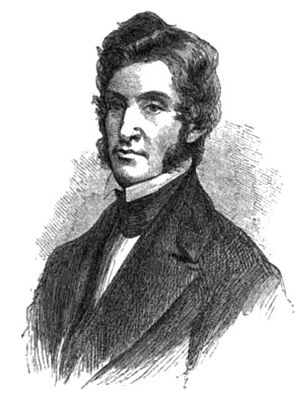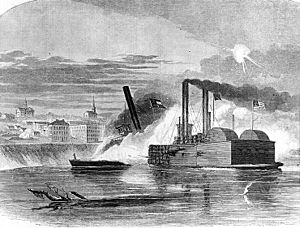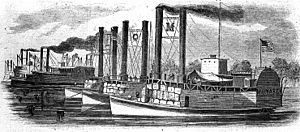United States Ram Fleet facts for kids
Quick facts for kids United States Ram Fleet |
|
|---|---|

United States Ram Fleet Approaching the City of Memphis, Tennessee to Demand Its Surrender
|
|
| Active | 1862 - 1864 |
| Country | |
| Branch | United States Army |
| Commanders | |
| Notable commanders |
Col. Charles Ellet Jr. Col. Alfred W. Ellet Col. Charles R. Ellet Lt. Col. John A. Ellet |
The United States Ram Fleet was a special group of steam-powered ram ships used by the Union Army during the American Civil War. These ships were designed to crash into enemy boats. The fleet was unique because it worked on its own, separate from the main Union Army and Navy. It reported directly to the Secretary of War, Edwin M. Stanton.
The ram fleet worked closely with the Mississippi River Squadron. Together, they fought against the Confederate River Defense Fleet. Their main goal was to control the important Mississippi River and its smaller rivers.
Colonel Charles Ellet Jr. created and led this fleet. Sadly, he died from a wound he got during the First Battle of Memphis. After his death, his brother, Alfred W. Ellet, took command. The fleet later became part of the Mississippi Marine Brigade. Command then passed to Charles Ellet Jr.'s nephews, Charles Rivers Ellet and later John A. Ellet. The unit was eventually moved under regular Army command and stopped operating in 1864.
Contents
How the Ram Fleet Started
Charles Ellet Jr. was a famous civil engineer. He was known for building the first suspension bridge in the United States. He also built the Wheeling Suspension Bridge, which was the longest of its kind back then.
When the Civil War began, Ellet believed that steam-powered ram ships would be very useful. He saw that the Confederate forces were building their own ram ships. For example, the Confederates took the USS Merrimack and turned it into a ram ship. This ship, renamed CSS Virginia, showed how powerful rams could be when it sank two Union ships, the USS Cumberland and USS Congress. This made Union leaders realize the potential of ram ships.
In March 1862, Secretary of War Edwin M. Stanton made Ellet a colonel. He gave Ellet permission to create the United States Ram Fleet on the Mississippi River. The Union Navy and Confederate forces were fighting for control of the river. Ellet convinced Stanton that ram ships would help the Union Navy win. Ellet and his fleet reported directly to Stanton, not to the Army or Navy.
Ellet bought nine of the fastest steamboats he could find. He then changed them into ram ships. Workers made their hulls stronger and filled the front ends with hard oak wood. They also protected the steam engines and the pilot houses (where the captain steered) with thick wooden planks. Iron bars were added for support, and strong iron points were put on the bows (front of the ships). These ships did not have any guns at first.
Ellet chose family members to be captains of the other ram ships. This included his brother Alfred W. Ellet, and his nephews John A. Ellet and Charles Rivers Ellet.
On May 25, the ram fleet joined the Mississippi River Squadron. This squadron was led by Charles H. Davis. Davis did not think the rams would be very effective. However, he allowed them to go with his gunboats down the river towards Memphis.
First Battle of Memphis
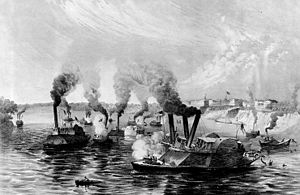
On June 6, Charles Ellet Jr. led four ram ships into the First Battle of Memphis. These ships were the USS Queen of the West, the USS Monarch, the USS Switzerland, and the USS Lancaster. Ellet had not planned his attack with Commander Davis. So, when they met the Confederate ships, the Queen of the West and the Monarch charged ahead of Davis's gunboats.
The Queen of the West rammed and sank the main Confederate ship, CSS Colonel Lovell. After this crash, the Queen of the West was attacked by two other Confederate ships. This attack broke off one of its paddle wheels, forcing it to stop on the riverbank. The Monarch then rammed and sank another Confederate ship. It also forced a third one aground and captured it. The Confederate forces lost badly at Memphis. They had many casualties and lost seven of their eight ships.
During the battle, Ellet was shot in the knee by a Confederate sharpshooter. This was the only serious injury on the Union side. Ellet refused to have his leg removed. Sadly, he died 15 days later from a blood infection caused by the injury. After his death, his brother, Alfred W. Ellet, took over command of the ram fleet.
Actions Near Vicksburg
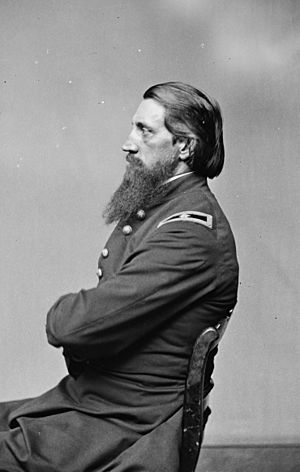
The ram fleet was never officially part of the Union Navy. However, in the summer of 1862, David Dixon Porter took command of the Mississippi River Squadron. He demanded and received full control over the ram fleet.
On June 26, Alfred W. Ellet commanded the Monarch and Charles Rivers Ellet commanded the Lancaster. They went into the Yazoo River near Liverpool, Mississippi. Their goal was to capture or destroy three Confederate gunboats. But when the Confederates saw the Union forces coming, they burned their own ships to prevent them from being captured.
On July 15, the Queen of the West and two other Union ships fought the Confederate ironclad ram CSS Arkansas in the Yazoo River. The Arkansas was badly damaged but managed to escape into the Mississippi River. It found safety under the Confederate cannons at Vicksburg, Mississippi. On July 22, the Queen of the West and another Union ship attacked the Arkansas again, even with the Vicksburg cannons firing. The Queen of the West rammed the Arkansas but only caused minor damage. It then rejoined the other Union ships.
The ram fleet ships also worked in the Yazoo River. They cleared out mines and fought against Confederate cannons on the riverbanks.
Mississippi Marine Brigade
In November 1862, Alfred W. Ellet created the Mississippi Marine Brigade. This was a special unit that could fight on both land and water. The ram fleet became a part of this brigade. On November 5, Charles Rivers Ellet was promoted to colonel. He was only 19 years old, making him one of the youngest colonels in the Union Army. He became the third Ellet family member to lead the ram fleet.
Under the leadership of Alfred and Charles Rivers Ellet, the ram ships played a big role in battles around Vicksburg, Mississippi in 1863. In January 1863, the ram fleet ships also took part in the Battle of Arkansas Post.
In February 1863, the Queen of the West sailed past the Confederate cannons at Vicksburg. It went to support Admiral David Farragut south of the city. The Queen of the West badly damaged the CSS Vicksburg and captured four transport ships that were supplying Confederate forces. The Queen of the West also operated on the Atchafalaya River. There, it destroyed Confederate supplies and burned three plantations. However, the Queen of the West was later captured by Confederate forces on the Red River. It then became a Confederate ship, renamed the CSS Queen of the West. The Mississippi Marine Brigade also fought in the Battle of Richmond, Louisiana and the Battle of Goodrich's Landing.
Because of poor health, Charles Rivers Ellet resigned on August 14, 1863. Command of the ram fleet then went to his cousin, John A. Ellet. In August 1863, the Mississippi Marine Brigade was placed under the command of General Ulysses S. Grant. The ram fleet was officially closed down in August 1864. Its remaining ships were then given other jobs.
Ships of the Fleet
The United States Ram Fleet included these ships:
- USS Avenger
- USS Dick Fulton
- USS Lancaster
- USS Lioness
- USS Mingo
- USS Monarch
- USS Queen of the West - This was the main ship of the fleet.
- USS Samson
- USS Switzerland
- USS T. D. Horner


